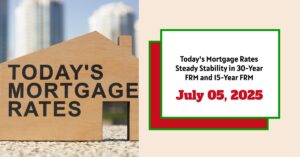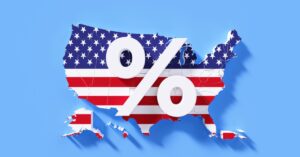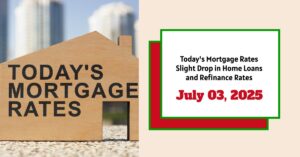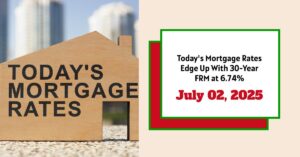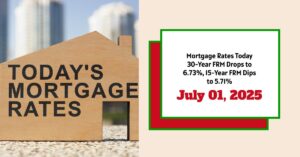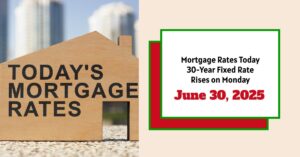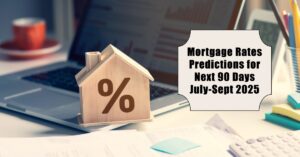As of July 5, 2025, the average mortgage rates remain stable, providing a sense of predictability for homebuyers and those looking to refinance. According to Zillom, the 30-year fixed mortgage rate is holding strong at 6.79%, the same as the previous week, while the 15-year fixed mortgage rate is steady at 5.86%. In this environment, potential buyers are encouraged that stable rates can allow for sound financial planning.
Today's Mortgage Rates July 5, 2025: Steady Stability in 30-Year FRM and 15-Year FRM
Key Takeaways
- Current Rates: The average 30-year fixed mortgage rate is 6.79%, consistent with last week.
- Refinance Rates: The 30-year fixed refinance rate is currently 7.07%, maintaining stability.
- Government Loans: FHA and VA loans are seeing slight variances, with FHA 30-year fixed rates at 6.45% and VA rates at 6.31%.
- Market Trends: Mortgage rates are expected to remain stable or slightly decline in the coming months, with predictions approaching 6.4% in the latter half of the year.
Current Mortgage Rates
Understanding current mortgage rates is crucial for potential homebuyers and those considering refinancing. According to recent data, let’s explore the national averages for various mortgage products:
Mortgage Rates Table
| Loan Type | Current Rate | 1 Week Change | APR | 1 Week APR Change |
|---|---|---|---|---|
| 30-Year Fixed Rate | 6.79% | 0.00% | 7.22% | -0.02% |
| 20-Year Fixed Rate | 6.54% | +0.28% | 6.92% | +0.29% |
| 15-Year Fixed Rate | 5.86% | +0.05% | 6.14% | +0.03% |
| 10-Year Fixed Rate | 5.58% | -0.12% | 5.77% | -0.23% |
| 5-Year ARM | 7.18% | -0.29% | 7.68% | -0.25% |
| 7-Year ARM | 7.63% | +0.48% | 7.84% | +0.02% |
Source: Zillow
Refinance Rates Today
Homeowners looking to refinance their existing mortgages will find the current refinance rates equally stable. Here’s a look at the average refinance rates:
Refinance Rates Table
| Loan Type | Current Rate | 1 Week Change | APR | 1 Week APR Change |
|---|---|---|---|---|
| 30-Year Fixed Refinance Rate | 7.07% | +0.01% | 7.22% | -0.02% |
| 15-Year Fixed Refinance Rate | 5.93% | 0.00% | 6.14% | +0.03% |
| 5-Year ARM Refinance Rate | 7.12% | -0.62% | 7.68% | -0.25% |
Mortgage Trends: What Does It Mean?
Stability in mortgage rates can be both good and bad for the market. While lower rates often spur home buying activity, steady rates provide predictability, allowing buyers to plan their purchases without fear of abrupt changes.
The current stability in mortgage rates can lead to increased buyer confidence. When rates change very little, potential homebuyers can make informed decisions without fearing a jump in borrowing costs. For instance, if you're eyeing a home priced around $500,000, with a steady interest rate, you can accurately forecast your monthly payments and overall financial commitments.
Example Calculation: Let’s break down a simple mortgage payment scenario:
- Home Price: $500,000
- Interest Rate: 6.79%
- Down Payment: 20% ($100,000)
- Loan Amount: $400,000
Using a mortgage calculator, your monthly payment would be approximately $2,601 (not including taxes and insurance). Stability in rates means you can rely on that payment when budgeting, unlike months where rates fluctuate unpredictably, which could adjust your cost significantly.
Economic Predictions
Experts foresee a decrease in mortgage rates towards the end of 2025, reaching approximately 6.4%. The Mortgage Bankers Association also supports this outlook, predicting rates to hover around the mid-6% range throughout 2025 and into early 2026.
Economic Influences on Mortgage Rates
- Inflation: Inflation pressures continue to play a significant role in shaping mortgage rates. Economists suggest that if inflation stabilizes, mortgage rates could reflect that improvement.
- Gross Domestic Product (GDP) Growth: The rate of economic growth also impacts mortgage rates; a slowing GDP could lead to lower rates, improving affordability for future homebuyers.
- Federal Reserve Policies: The Federal Reserve’s decisions regarding interest rates and inflation will continue to influence mortgage rates. If the Fed raises rates to combat inflation, mortgage rates could increase. Conversely, should they lower rates to stimulate the economy, there's potential for mortgage rates to drop.
Why Stability Matters
Stable mortgage rates can be beneficial, creating certainty for buyers. Homeowners are more likely to make a purchasing decision when they can anticipate costs accurately. Additionally, stable rates encourage buyers to enter the market, as they no longer fear a rapid surge in borrowing costs.
The Psychological Effect of Stable Rates
The psychological effect of mortgage rate stability can also contribute to an increase in home sales. Homeowners and buyers tend to act when they feel confident about future financial commitments. Stable rates eliminate a significant variable that causes anxiety and hesitation in decision-making.
Government Loan Programs
Government-backed loans, like FHA and VA loans, also see varying rates. For instance, the FHA’s 30-year fixed rate currently sits at 6.45%, which is down 0.79% from the previous week. Conversely, the VA loans report an increase of 0.04%, now at 6.31%.
Government Loans Table
| Loan Type | Current Rate | 1 Week Change | APR | 1 Week APR Change |
|---|---|---|---|---|
| FHA 30-Year Fixed Rate | 6.45% | -0.79% | 7.47% | -0.81% |
| VA 30-Year Fixed Rate | 6.31% | +0.04% | 6.51% | +0.03% |
| FHA 15-Year Fixed Rate | 5.57% | -0.70% | 6.54% | -0.70% |
| VA 15-Year Fixed Rate | 5.76% | -0.02% | 6.12% | +0.01% |
These government loans serve as vital options for first-time buyers or those with limited financial means, allowing access to more affordable financing options. For example, lower down payment requirements and competitive interest rates make FHA loans appealing to many individuals entering the housing market.
Related Topics:
Mortgage Rates Trends as of July 4, 2025
Will Mortgage Rates Drop or Increase in July 2025: Key Predictions
Mortgage Rate Predictions for the Next 3 Years: 2026, 2027, 2028
The Path Ahead for the Housing Market
Looking ahead, the U.S. housing market is anticipated to experience several changes, primarily because of the stability in rates and the growing demand for housing.
- Home Inventory Dynamics: The ongoing pressure of rising institutional buyer interest may lead to an uptick in housing inventory on the market, potentially balancing the current supply-demand dynamics. More homes for sale lowers competition and can help moderate price growth, benefitting buyers needing affordable housing options.
- New Construction Projects: As demand increases for new homes, builders are likely to ramp up construction projects to satisfy market needs. This can lead to job creation and bolster the economy, but also comes with its challenges in terms of labor availability and material costs.
- Market Adjustments: Should rates move lower, even slightly, even more buyers may confidently enter the market. This uptick in demand could signal stronger recovery within the sector, creating a favorable environment for prospective homeowners.
- Long-term Investment Opportunities: Individuals contemplating long-term homeownership might find this an opportune time to secure fixed-rate mortgages. The assurance of a fixed payment over 30 years can be an invaluable asset against the backdrop of fluctuating economic conditions.
Summary:
As of July 5, 2025, mortgage and refinance rates present a landscape of stability, which could be enticing for buyers looking to make long-term commitments in the housing market. With predictions suggesting a potential decline in rates later this year, it may be a strategic time for buyers to act. Moreover, government loan options continue to provide alternatives for those looking to secure favorable terms.
Invest Smarter in a High-Rate Environment
With mortgage rates remaining elevated this year, it's more important than ever to focus on cash-flowing investment properties in strong rental markets.
Norada helps investors like you identify turnkey real estate deals that deliver predictable returns—even when borrowing costs are high.
HOT NEW LISTINGS JUST ADDED!
Connect with a Norada investment counselor today (No Obligation):
(800) 611-3060
Also Read:
- Will Mortgage Rates Go Down in 2025: Morgan Stanley's Forecast
- Mortgage Rate Predictions 2025 from 4 Leading Housing Experts
- 30-Year Fixed Mortgage Rate Forecast for the Next 5 Years
- 15-Year Fixed Mortgage Rate Predictions for Next 5 Years: 2025-2029
- Will Mortgage Rates Ever Be 3% Again in the Future?
- Mortgage Rates Predictions for Next 2 Years
- Mortgage Rate Predictions for Next 5 Years
- Mortgage Rate Predictions: Why 2% and 3% Rates are Out of Reach
- How Lower Mortgage Rates Can Save You Thousands?
- How to Get a Low Mortgage Interest Rate?
- Will Mortgage Rates Ever Be 4% Again?
